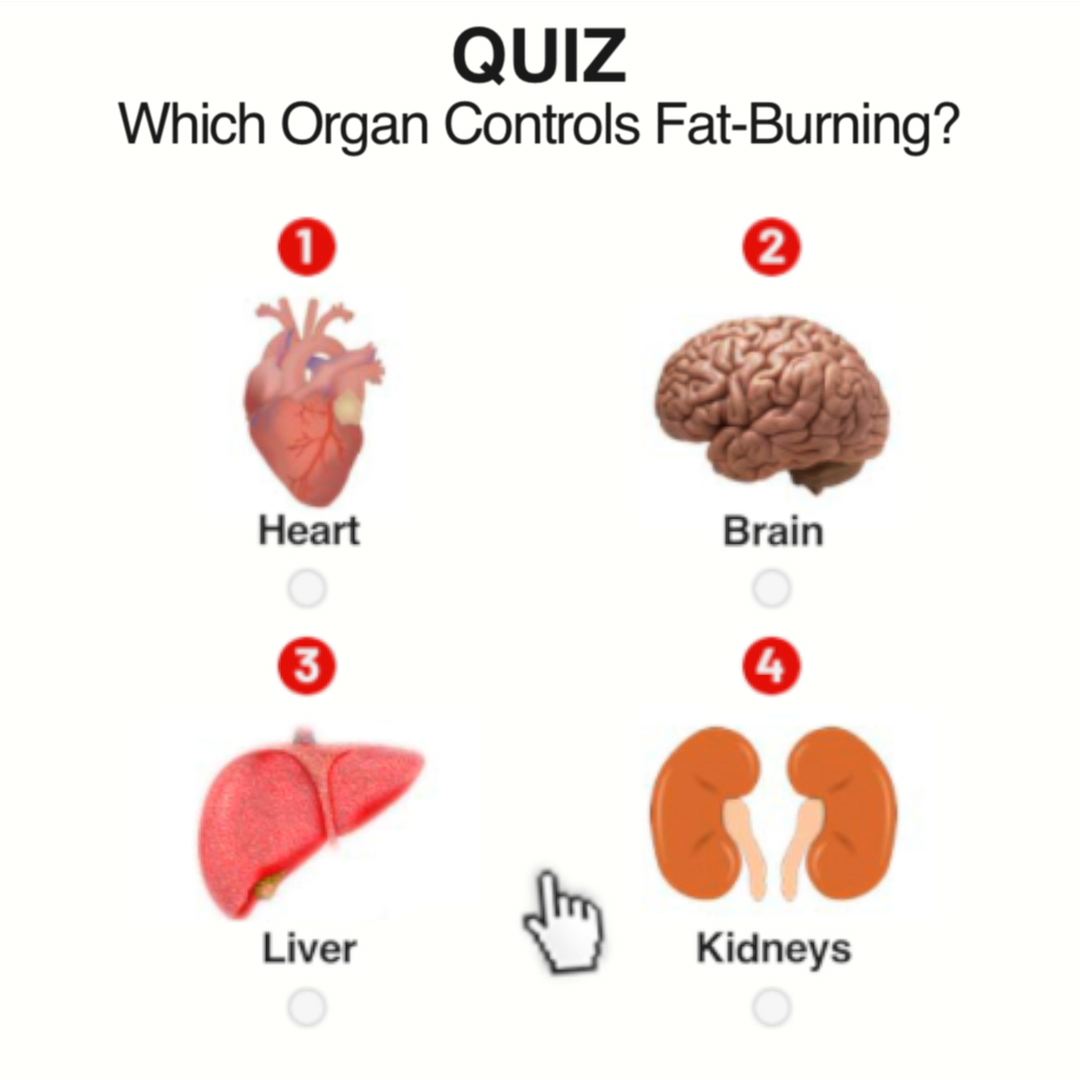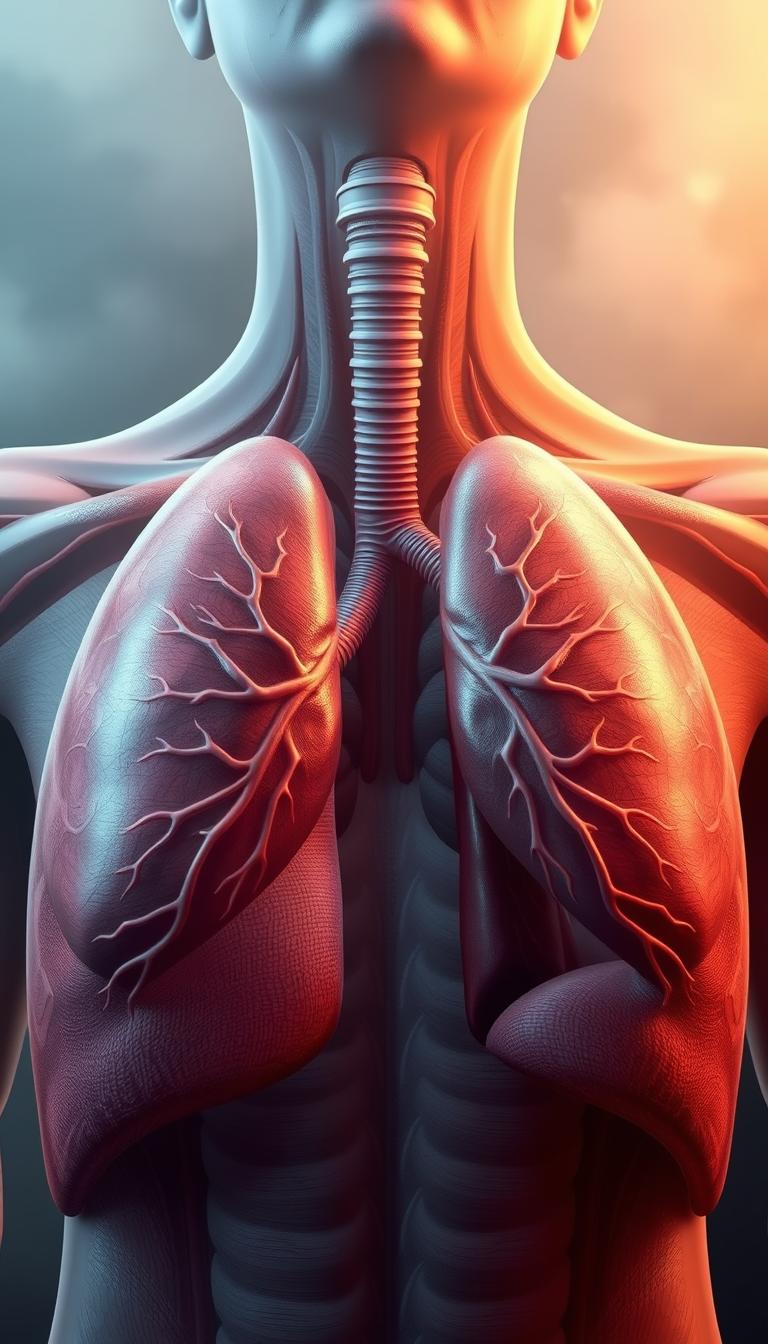
Have you ever thought about how every breath keeps you alive? Your respiratory system works all the time to send oxygen to your cells. Without it, you’d feel dizzy fast.
This network of organs, from your nose to lungs, handles the breathing process. It gives you energy and takes away bad gases like carbon dioxide. Your lungs have 300 million tiny air sacs, as big as a tennis court, for gas exchange. But we often ignore this important work.
Key Takeaways
- Your respiratory system manages the oxygen and carbon dioxide balance essential for every heartbeat, thought, and movement.
- Every breath you take filters, warms, and delivers oxygen through 145 square meters of alveoli.
- Without proper care, pollution or illness can disrupt this delicate respiratory system function.
- The diaphragm’s rhythmic contractions keep oxygen flowing, even while you sleep.
- Protecting your lungs isn’t just about avoiding smoke—it’s about safeguarding your body’s energy engine.
Understanding Your Respiratory System: An Overview
Your respiratory system is a network of organs and muscles. It keeps you alive by managing every breath. A respiratory system overview shows its role in sustaining life through vital processes.
The Primary Function of Your Respiratory System
Your respiratory system handles the gas exchange function. When you inhale, oxygen goes to tiny air sacs (alveoli) in your lungs. There, oxygen enters your blood, and carbon dioxide is expelled.
This exchange fuels every action, from walking to thinking.
How Your Respiratory System Interacts with Other Body Systems
Far from working alone, your respiratory system collaborates with other systems:
- Circulatory System: Oxygen absorbed by red blood cells flows through arteries, veins, and capillaries. It delivers energy to muscles and organs.
- Nervous System: Your brainstem’s medulla oblongata monitors CO2 levels. It adjusts breathing rate automatically, even as you sleep.
- Musculoskeletal System: The diaphragm and intercostal muscles between ribs expand your chest cavity. Facial muscles help control airflow during activities like singing or laughing.
Why Respiratory Health Matters in Your Daily Life
Strong respiratory health importance directly impacts how you feel daily. Poor respiratory function can lead to fatigue and shortness of breath during exercise. It can also weaken your immunity.
Protecting this system through exercise, avoiding pollutants, and staying hydrated boosts energy and mental clarity. Small choices like avoiding smoking or using a mask in polluted areas safeguard your ability to breathe easily every day.
The Journey of a Breath: How You Breathe
Every breath you take follows a precise sequence of movements. Let’s break down the steps behind breathing mechanics that keep you alive and healthy every day.
The Mechanics of Inhalation and Exhalation
When you breathe in, your diaphragm function takes the lead. This dome-shaped muscle beneath your lungs tightens and flattens, expanding your chest cavity. Intercostal muscles between your ribs also pull outward, creating space. Air rushes in, filling your lungs like a balloon.
Exhalation reverses this: muscles relax, and air flows out. This cycle repeats roughly 20,000 times daily without you even thinking about it.
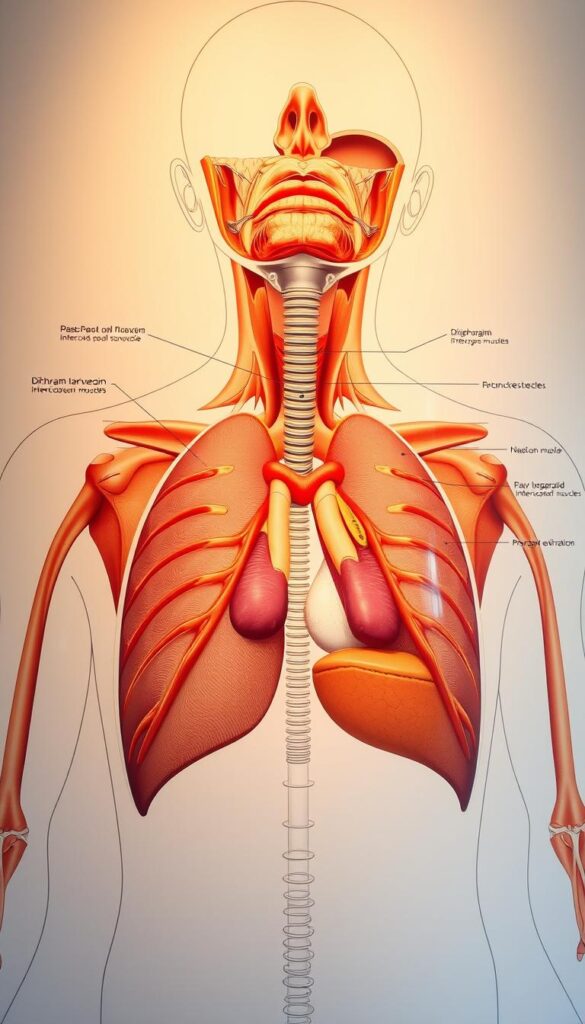
- Inhalation: Diaphragm contracts → chest expands → air enters.
- Exhalation: Diaphragm relaxes → chest shrinks → air exits.
Controlling Your Breathing: Voluntary and Involuntary Processes
You can control breathing consciously—like slowing your breath during yoga or speaking in long sentences. But most of the time, your brainstem handles it automatically. Even while sleeping, sensors in your blood and brain monitor oxygen and carbon dioxide levels, adjusting your rate without your input.
How Your Body Regulates Breathing Rate
Your body’s “breathing control” system is smart. Special cells in your blood vessels and brain sense when carbon dioxide builds up. During exercise, your brain tells muscles to breathe faster. Stress or illness can also change your rhythm.
Think of it like a thermostat: your body adjusts to keep oxygen levels just right.
“Breathing is a dance between your muscles and nervous system.” — American Lung Association
Understanding these steps helps you appreciate how your body balances inhalation and exhalation seamlessly—every moment of every day.
Key Structures That Make Up Your Respiratory System
Your respiratory system anatomy has a network of that work together as your . Let’s look at the parts that help you breathe:
- Upper respiratory tract: Nose, nasal cavity, sinuses, pharynx, and larynx. These parts filter, warm, and humidify air before it gets to your lungs.
- Lower respiratory tract: Trachea, bronchi, bronchioles, and lungs. The here has alveoli—tiny air sacs where oxygen goes into your blood and CO₂ comes out.
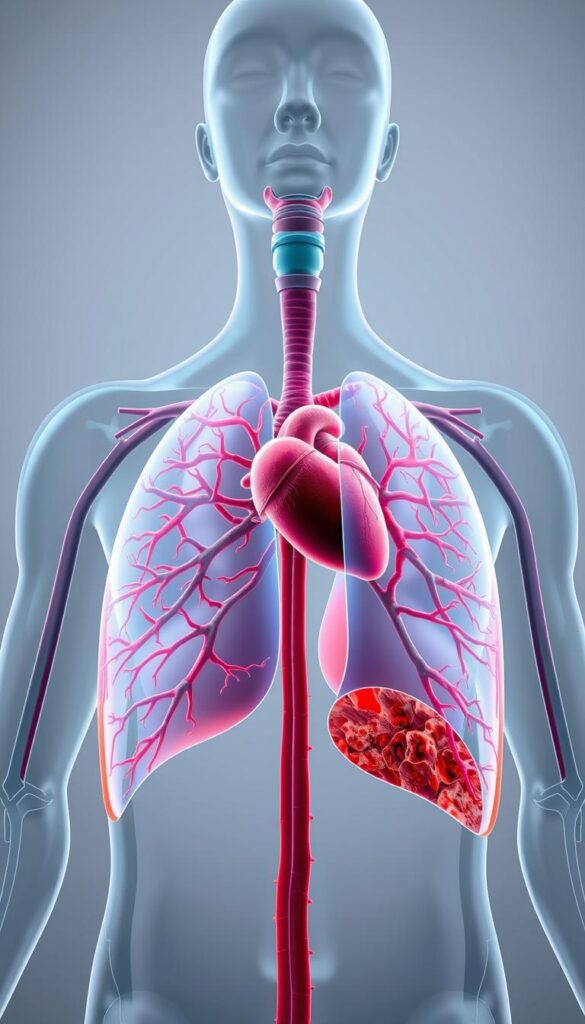
Your diaphragm, a strong muscle under your lungs, contracts to make your chest expand and draw air in. With rib muscles, it makes every breath possible. Each part of this system has a special job—from catching dust in your nose to swapping gases in alveoli. Knowing these parts helps you see how your work together as one .
From Nose to Lungs: The Path of Air Through Your Body

Every breath you take follows a precise route through your airway passage. Let’s break down this journey step by step:
Nasal Passage: Your Built-In Air Filter
Your nose isn’t just for smelling—it’s your first line of defense. Tiny hairs and mucus in the nasal passages trap dust and germs. These defenses work with sinuses to warm and moisten air before it moves deeper into your respiratory tract. Think of it like a natural air purifier built into your face!
Throat & Trachea: The Highways of Breathing
Air passes through your throat (pharynx) and into the trachea, also called the windpipe. Cartilage rings keep this airway passage open, even when you swallow. The epiglottis acts like a lid, closing to prevent food from entering your airways during meals.
Bronchial Tree: Branching to Every Corner
Once air reaches your lungs, it enters the bronchial tree. This network splits like branches on a tree:
- Two main bronchi carry air to each lung
- These divide into smaller bronchioles
- End in clusters of alveoli where gas exchange begins
Alveoli: The Tiny Powerhouses of Exchange
Over 600 million alveoli form microscopic air sacs. Their thin walls let oxygen slip into capillaries, while carbon dioxide exits. This alveoli function is vital—without it, your cells couldn’t get the oxygen they need.
| Respiratory Tract Parts | Upper Tract | Lower Tract |
|---|---|---|
| Location | Nose, sinuses, throat | Trachea, bronchi, alveoli |
| Main Job | Filter & warm air | Gas exchange |
| Key Structures | Epiglottis, nasal hairs | Bronchial tree, capillaries |
Each breath follows this intricate path, ensuring oxygen reaches every cell. Protecting this system means protecting your health!
The Science of Gas Exchange: Oxygen In, Carbon Dioxide Out
Every time you breathe, a tiny dance of gases happens. The gas exchange process takes place in your lungs’ alveoli. These tiny air sacs are where oxygen transport starts.
Think of your red blood cells as taxis at an airport. When oxygen gets into your alveoli, hemoglobin in your blood picks it up. It then drives oxygen to your body’s cells.
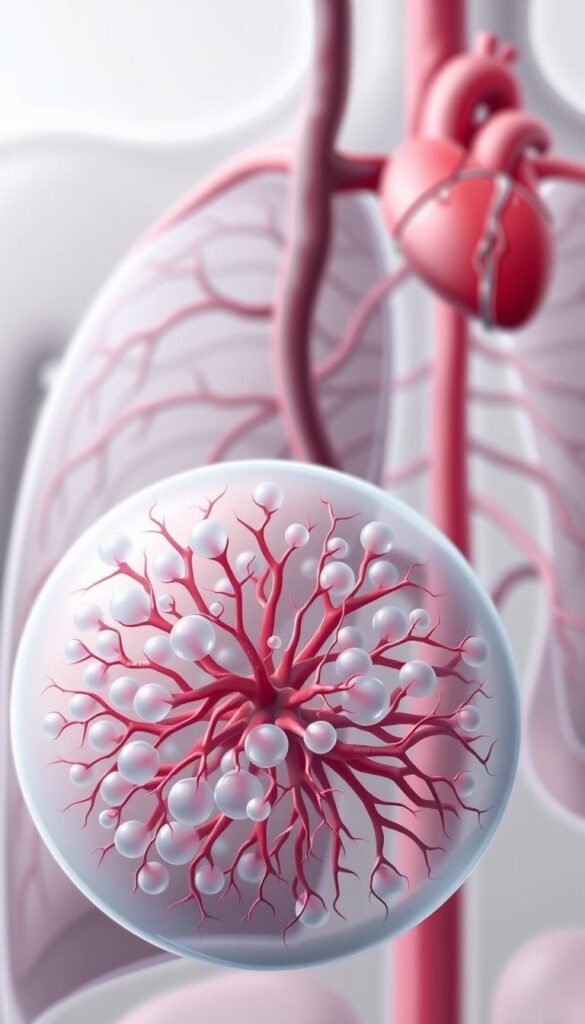
Your cells make carbon dioxide, or “luggage” that needs to go out. This carbon dioxide removal is like reverse logistics. Carbon dioxide goes back to your lungs through your blood.
In your lungs, diffusion in lungs happens. Oxygen moves into blood, and carbon dioxide moves out. This happens without using any energy. It’s your body’s own efficiency.
- Step 1: Oxygen-rich air reaches alveoli, thin-walled structures surrounded by capillaries.
- Step 2: Oxygen diffuses across alveolar walls into blood, binding to hemoglobin.
- Step 3: Carbon dioxide moves from blood into alveoli, ready for exhalation.
This process never stops, even when you’re reading. Alveoli’s design helps it work well. Things like the V/Q ratio and Fick’s law help gases move easily.
If this process goes wrong (like in asthma or pulmonary edema), your body has a hard time. It can’t keep the balance right.
Common Respiratory Conditions You Should Know About
Your health depends on your respiratory system. Knowing about respiratory diseases and lung conditions is key. This helps you take action early.
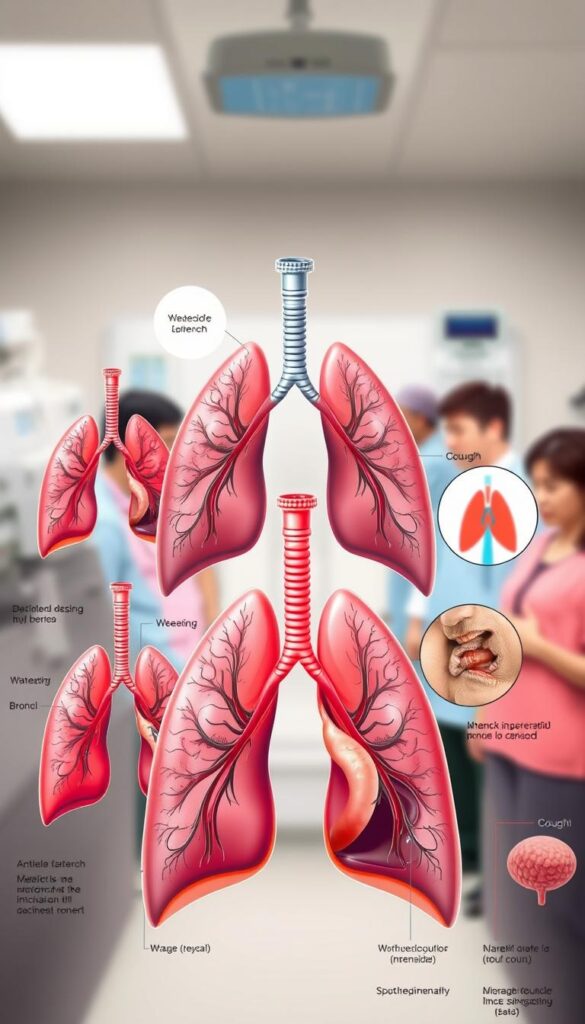
| Type | Examples | Symptoms | Duration |
|---|---|---|---|
| Acute | Colds, influenza, pneumonia | Cough, fever, congestion | Days to weeks |
| Chronic | Asthma, COPD, lung cancer | Wheezing, persistent cough | Months to years |
Acute Respiratory Issues
- Respiratory infections like pneumonia or bronchitis often resolve with treatment.
- RSV and influenza spread quickly, causing fever and breathing problems.
Chronic Respiratory Diseases
- Asthma inflames airways, causing wheezing and shortness of breath.
- COPD, the third-leading cause of U.S. deaths, includes emphysema and chronic bronchitis.
- Lung cancer, the top cancer killer, often linked to smoking.
When to Seek Care
Visit a doctor if you experience:
- Severe shortness of breath during daily tasks
- Coughing up blood
- High fever with chest pain
- Worsening chronic symptoms
Early care improves outcomes for many respiratory diseases. Prioritize your health by knowing these signs.
How Your Lifestyle Impacts Your Respiratory Health
Your choices today shape your respiratory health factors tomorrow. Small changes in daily habits can protect your lungs or put them at risk. Let’s explore how to make choices that keep your breathing strong.
The Effects of Smoking and Vaping
“Smoking is the leading cause of lung cancer and COPD, according to the American Lung Association.”
Every puff of a cigarette or vape harms your lungs. Smoking effects on lungs include damaged cilia, thicker mucus, and inflamed airways. Smokers face a 12–13x higher risk of COPD-related deaths than non-smokers. Even secondhand smoke raises risks. Quitting at any age reduces harm—your lungs begin healing within days.

Air Pollution and Your Lungs
Pollution doesn’t just cloud the sky—it harms your air quality impact. Outdoor smog and indoor allergens strain your lungs. Nine in 10 urban residents breathe polluted air daily. Protect yourself with these steps:
- Track air quality indexes (AQI) before outdoor activities.
- Use HEPA filters indoors to trap allergens and particles.
- Avoid burning wood or using harsh cleaning sprays at home.
Exercise and Respiratory Fitness
Regular movement boosts respiratory fitness. Exercise strengthens breathing muscles and improves oxygen use. Aim for 30 minutes of moderate activity (walking, swimming) five days a week. Try these options:
- Aerobic exercises: Build endurance and lung capacity.
- Pilates or yoga: Enhance core strength to support breathing muscles.
- Indoor workouts when air quality is poor.
Even those with lung conditions can benefit—talk to a doctor to tailor your routine. Every step you take helps your lungs breathe easier.
Breathing Exercises to Strengthen Your Respiratory System
Simple breathing techniques can change your respiratory health. Lung exercises like diaphragmatic breathing and respiratory training boost oxygen flow. They ease tension and support lung function. These practices need no equipment—just your breath.
Alternate nostril breathing, a yoga practice, can improve lung capacity and reduce stress.

| Exercise | Steps | Benefits | ||
|---|---|---|---|---|
| Diaphragmatic Breathing | 1. Place one hand on your chest and one on your belly. | 2. Inhale deeply through your nose, letting your belly rise. | 3. Exhale slowly through pursed lips, belly falls. | Strengthens diaphragm, improves oxygen intake, reduceses shortness of breath. |
| Pursed-Lip Breathing | Inhale through nose (2 counts). Exhale through pursed lips (4 counts). | Reduces air trapping, easies COPD symptoms. | ||
| Box Breathing | Inhale 4 sec. Hold 4 sec. Exhale 4 sec. Repeat 4-8 times. | Calms nervous system, enhances focus. | ||
| 4-7-8 Technique | Inhale 4 sec, hold 7 sec, exhale 8 sec. | Reduces anxiety, improves sleep quality. |
Do each exercise 5 times, 3x daily. For COPD, diaphragmatic breathing helps restore diaphragm function. This naturally handles 80% of your breathing work. Combine these routines with splinted coughing for better mucus clearance. Always check with a healthcare provider if you have chronic conditions.
Regular practice boosts lung capacity (6 liters average) and supports respiratory muscles. These respiratory training methods are safe for most. They can be done anywhere—strengthening your breath with every session.
Nutrition and Hydration: Supporting Your Respiratory System Through Diet
Your respiratory system needs the right food and water to work well. Eating a diet for lung health can help. It can make breathing easier and give you more energy. For people with COPD, eating less carbs and more fats might help.
Let’s look at how food and water help your lungs.
Foods That Support Lung Health
- Antioxidant-rich options: Apples, peppers, and tomatoes have quercetin and vitamin C. They slow lung decline and lower COPD risk.
- Beets and beet greens: Nitrates help your body take in more oxygen. This is good for those with COPD or high blood pressure.
- Leafy greens and pumpkin: Carotenoids like beta-carotene in spinach, kale, and pumpkin fight inflammation. They also improve lung function.
- Turmeric and olive oil: Curcumin and polyphenols in them reduce inflammation. Zinc in oysters and selenium in Brazil nuts protect against lung cancer.
- Avoid processed foods, sugary drinks, and white bread. They increase inflammation and oxidative stress.
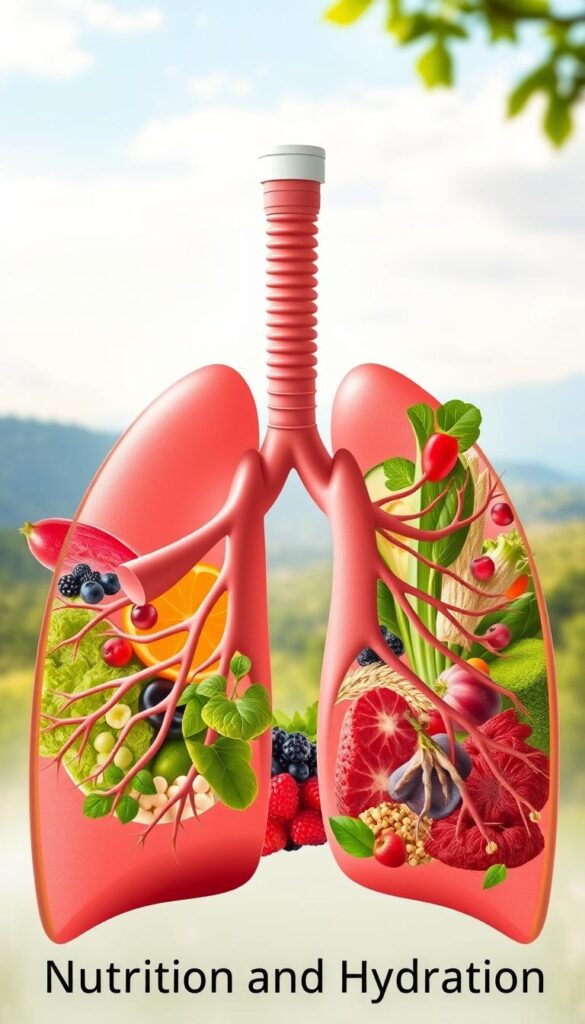
The Importance of Proper Hydration
Drinking enough water keeps your airway mucus thin. This prevents clogs and infections. Drink water, herbal teas, or diluted juices. Look for pale yellow urine and steady energy to know you’re hydrated.
For COPD patients, eating small meals and sitting up straight while eating can help with breathing.
Supplements for Respiratory Support
Before taking respiratory supplements, talk to your doctor. Some research shows:
- Vitamin D: Boosts immunity and reduces asthma symptoms.
- NAC (N-acetylcysteine): Thins mucus and reduces COPD flare-ups.
- Omega-3s (fish oil): Eases inflammation in asthma and COPD.
Always talk to a healthcare provider before taking supplements. This is to avoid bad interactions or taking too much.
Protecting Your Respiratory System During Illness Seasons
Keeping your respiratory system safe is key during flu, cold, or virus outbreaks. Simple habits like respiratory protection and immune support can stop infections. They also keep your breathing strong.

First, get vaccines. Get shots for flu, COVID-19, and pneumonia. Talk to your doctor about what’s best for you, especially if you have asthma, COPD, or a weak immune system. Vaccines are a top way to prevent illness.
- Wash hands often with soap for at least 20 seconds to stop germs.
- Stay home if you have symptoms like fever, cough, or runny nose. Return to daily activities only after 24 hours fever-free without medicine.
- For 5 days after recovery, clean surfaces, wear masks, and keep distance from others.
Boost your immune support with sleep (7-8 hours nightly), stress reduction, and nutrient-rich foods. Eat citrus, leafy greens, and lean proteins. Avoid smoking or vaping, which harms your respiratory system.
Seek emergency care immediately if you experience trouble breathing, chest pain, or bluish lips/face.
If you’re at higher risk—like children under 5, adults over 65, or those with heart disease—take extra steps. Use air purifiers, masks in crowded places, and avoid sick contacts. These steps protect your seasonal respiratory health and help keep others safe.
Conclusion: Appreciating the Remarkable Design of Your Respiratory System
Every breath you take is amazing. Your respiratory system works hard, exchanging oxygen and carbon dioxide thousands of times a day. It makes sure your body gets the oxygen it needs, even when you’re very active.
The trachea’s flexible cartilage and the alveoli’s tiny air sacs are key to gas exchange. Your lungs have lobes that adjust to your body’s needs. This shows how important lung care is in our daily lives.
Think about how precise your respiratory system is. It has sensors that adjust your breathing based on oxygen levels. The Hering-Breuer reflex also stops your lungs from getting too full.
This system manages acid levels during exercise and sleep. But, you play a big role in keeping it healthy. Regular check-ups and avoiding pollutants like smoke are crucial. Drinking water and doing breathing exercises also help.
Take a moment to notice your breath. Each inhale fills 300 million alveoli, helping you breathe better. Protecting this system is not just about avoiding harm. It’s about appreciating every breath.
Small steps like quitting smoking or using air filters can make a big difference. Remember, your respiratory system needs your help. By taking care of your lungs, you live a healthier, more vibrant life. Breathe deeply and honor this vital system that keeps you alive, moment by moment.
FAQ
What is the primary function of the respiratory system?
Your respiratory system brings oxygen into your body. It also removes carbon dioxide. This is key for your cells to have energy.
How does the respiratory system interact with other body systems?
It works with the circulatory system to get oxygen to cells. It also teams up with the nervous system for breathing control. Plus, it uses the muscular system for breathing mechanics.
Why is respiratory health important for my daily life?
Good respiratory health boosts your energy and physical performance. It also improves your thinking and overall life quality. This lets you enjoy your daily activities more.
How does breathing occur in my body?
Breathing happens when your diaphragm and intercostal muscles contract and relax. This creates pressure changes. These changes let air move in and out of your lungs.
Can I control my breathing?
Yes, you can control your breath for things like speaking or swimming. But, your body breathes automatically, even when you’re asleep.
What role does the brain play in regulating breathing?
Your brain’s respiratory center watches carbon dioxide levels in your blood. It adjusts your breathing to keep balance. This is especially true during exercise or stress.
What are the main parts of the respiratory system?
The key parts are the nose, mouth, throat, trachea, bronchi, and lungs. They all work together for breathing.
How does air travel from my environment to my lungs?
Air goes in through your nose, gets filtered and warmed. Then, it goes through your throat and trachea. It branches into the bronchial tree and ends in the alveoli for gas exchange.
What happens during gas exchange in the alveoli?
In the alveoli, oxygen goes from the air into your blood. Carbon dioxide goes from your blood into the air. This lets your body manage gas exchange well.
What common respiratory conditions should I be aware of?
You should know about the common cold, bronchitis, asthma, COPD, and lung cancer. Each affects breathing differently.
How does smoking affect my respiratory health?
Smoking harms your cilia, increases mucus, and causes airway inflammation. This raises the risk of conditions like bronchitis, emphysema, and lung cancer.
What foods can support my lung health?
Eat foods with antioxidants, like fruits and veggies with vitamins A, C, and E. Also, choose foods with omega-3s and anti-inflammatory properties. They protect your lung tissues.
What practical steps can I take to protect my respiratory health during illness seasons?
To stay healthy, get vaccinated, practice good hygiene, and manage stress. Also, get enough sleep and keep indoor air clean with proper ventilation.









